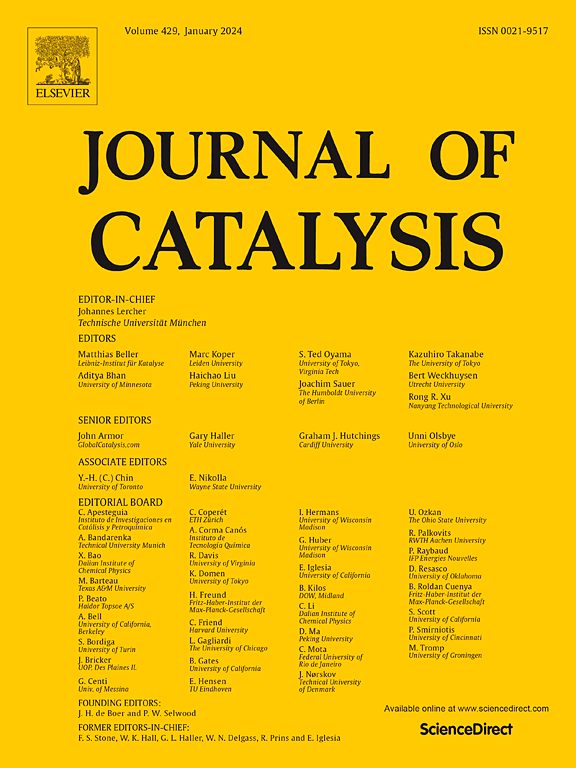预处理的碳添加剂可以在保持性能的同时减少CoNiFe氧化物基OER电催化剂中的金属负载
IF 6.5
1区 化学
Q2 CHEMISTRY, PHYSICAL
引用次数: 0
摘要
Co、Ni和Fe的混合氧化物(MO)已成为碱性电解(AWE)中析氧反应(OER)的重要催化剂。虽然它们比用于质子交换膜(PEM)水分解的贵金属催化剂便宜得多,但Co的有限可用性以及Co和Ni开采的环境足迹异常恶劣,仍然是扩大AWE产能的挑战。在这种情况下,我们提出了一种有希望的方法来减少金属含量,同时保持催化性能。以本课组近期对CoNiFeOx OER催化剂的研究为基础,从材料结构和电催化活性两方面评价了不同合成阶段、不同负载下经预处理的火神碳XC-72R (VC)的掺合物。优化后的MO-VC复合材料在1.56 V vs. RHE下的质量活度为370 a gCoNiFe-1, Tafel斜率为39.0 mV dec−1。在阴离子交换膜(AEM)电解槽中验证了在实际AWE条件下的长期稳定性能。通过结合原位x射线吸收光谱、电化学活性表面积分析以及电化学阻抗谱,了解了碳外加剂的影响。结果表明,在电位偏压下,碳外加剂对MO畴的电子结构有良好的影响。本文章由计算机程序翻译,如有差异,请以英文原文为准。

Pre-treated carbon additive enables reduction of metal loading in CoNiFe oxide-based OER electrocatalysts while maintaining performance
Mixed oxides (MO) of Co, Ni, and Fe have emerged as promising catalysts for the oxygen evolution reaction (OER) in alkaline water electrolysis (AWE). Although they are significantly cheaper than the precious metal catalysts used for proton exchange membrane (PEM) water splitting, the limited availability of Co and the exceptionally poor environmental footprint of Co and Ni mining remain challenges for scaling up AWE capacities. In this context, we present a promising approach toward reducing the metal content while preserving the catalytic performance. Based on a recent work on CoNiFeOx OER catalysts from our group, admixture of pre-treated Vulcan carbon XC-72R (VC) at different synthesis stages in various loadings was evaluated in view of material structure and electrocatalytic activity. Attractive performance characteristics were obtained for the optimized MO-VC composite material, e.g., a mass activity of 370 A at 1.56 V vs. RHE and a Tafel slope of 39.0 mV dec−1. Stable long-term performance under practical AWE conditions was confirmed in an anion exchange membrane (AEM) electrolyzer. An understanding of the effect of carbon admixture was achieved by combining in situ X-ray absorption spectroscopy, analysis of the electrochemically active surface area, as well as electrochemical impedance spectroscopy. The results point toward a benign impact of carbon admixture on the electronic structure of the MO domains under potential bias.
求助全文
通过发布文献求助,成功后即可免费获取论文全文。
去求助
来源期刊

Journal of Catalysis
工程技术-工程:化工
CiteScore
12.30
自引率
5.50%
发文量
447
审稿时长
31 days
期刊介绍:
The Journal of Catalysis publishes scholarly articles on both heterogeneous and homogeneous catalysis, covering a wide range of chemical transformations. These include various types of catalysis, such as those mediated by photons, plasmons, and electrons. The focus of the studies is to understand the relationship between catalytic function and the underlying chemical properties of surfaces and metal complexes.
The articles in the journal offer innovative concepts and explore the synthesis and kinetics of inorganic solids and homogeneous complexes. Furthermore, they discuss spectroscopic techniques for characterizing catalysts, investigate the interaction of probes and reacting species with catalysts, and employ theoretical methods.
The research presented in the journal should have direct relevance to the field of catalytic processes, addressing either fundamental aspects or applications of catalysis.
 求助内容:
求助内容: 应助结果提醒方式:
应助结果提醒方式:


